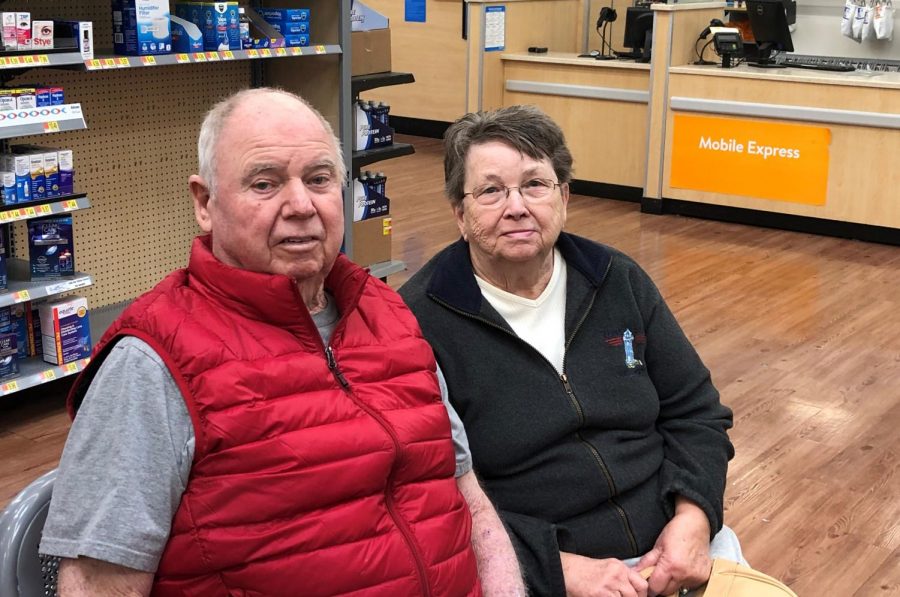WSU responds to COVID-19
Online classes are part of emergency plan, closing campus is last resort; as of Thursday there are 70 confirmed cases, 10 deaths in Washington
Bill, left, and Stella Heston are not concerned about the novel coronavirus. They are Pullman retirees in their 80s.
March 6, 2020
Students and locals share concerns as WSU health leaders coordinate response efforts to prepare for a local COVID-19 outbreak in Pullman.
Washington State Governor Jay Inslee issued an emergency declaration last Friday due to more confirmed cases and increasing deaths in Washington.
By Monday, medical experts from WSU and Whitman County Health Department (WCHD) said they expect COVID-19 to reach Pullman eventually.
Troy Henderson, director of Whitman County’s Department of Public Health, said WCHD is reviewing their emergency management plans.
“This coronavirus seems to be different enough from existing coronaviruses — that it is novel to our immune system,” he said. “The uniqueness of COVID-19, from other cold and flu viruses, has fueled scientific agreement that continued spread in Washington is expected.”
Henderson said WCHD expects to see cases of COVID-19 in healthy, young people in Pullman.
Guy Palmer, senior director of WSU Global Health and director of the Robert R. Fast Infectious Diseases Research Laboratory, said local cases of COVID-19 are likely because of confirmed “community transmission” of the virus.
“COVID-19 is moving from cluster-to-cluster, or from areas with the virus to new areas and starting new clusters,” he said. “It’s moving with people that may or may not have symptoms. That is certainly the pattern globally and I expect that to continue.”
As of Thursday, there are 70 confirmed cases in Washington and 10 deaths. State numbers are updated daily at 11 a.m. on the Washington State Department of Health’s (WSDH) COVID-19 website. 231 Washingtonians are under quarantine, according to the website. This is based on symptoms or known exposure to people confirmed with the virus.
“Quarantine alone does not stop the spread of the virus, so the idea that you can completely quarantine a community away from the virus is clearly not the case,” Palmer said.
He said having access to COVID-19 tests to confirm cases locally will be key to understanding the future spread of the disease.
“As we pick up looking for more cases, we will find more cases across the globe as we look,” Palmer said.
A Pullman native in her 40s said she is very familiar with federal quarantine protocols. She just moved back from Hawaii and landed in Pullman on Tuesday, she said.
Her friends and church members in Honolulu, Eric and Debra Pagan, were aboard the virus-stricken Diamond Princess cruise ship.
“They have been in mandatory quarantine for almost a month, isolated on the cruise ship, before being shipped to Travis Air Force Base in California,” she said.
She said the Diamond Princess is thought to be the source of COVID-19’s entry into America. The federal government allowed 14 people on the ship to fly back to the U.S. because they had no symptoms then, she said. The Pagans told her during a phone call on Tuesday that they are out of quarantine and have made it home to Hawaii, she said.
She asked The Daily Evergreen to stay anonymous.
Phil Weiler, Vice President of WSU Marketing and Communications, explained that the Incident Command Team (ICT) is the head group dedicated to the WSU-wide COVID-19 response.
Weiler said the team increased focus on COVID-19 a week ago, due to the continued spread in Washington and Inslee’s emergency declaration last Friday.
Henderson said the COVID-19 State of Emergency was declared to initiate state-wide response plans, including making COVID-19 diagnostic tests available within the state. Last Friday, COVID-19 tests were not available in the state of Washington.
Before the emergency declaration issued by Inslee, all suspected COVID-19 samples had to be sent to the Center of Disease Control (CDC) in Atlanta. Henderson said the CDC’s testing capacity is limited and overwhelmed.
With the declaration, suspected cases are now being tested in WSDH’s state lab in Shoreline, Washington, he said.
Henderson said COVID-19 testing at the CDC would take 36 hours minimum. However, there are many reports of CDC’s testing lagging up to a week, according to Time Magazine.
According to Inslee’s COVID-19 statement on his website, there are increased efforts in action since declaring a state emergency.
“This means our state can respond quickly and effectively,” the statement said.
At a WSDH news conference last Thursday, Scott Lindquist, WSDH Epidemiologist for Communicable Diseases, said the Washington lab can process up to 26 virus tests per day, with same-day results.
Weiler said the WSU team follows county, state and federal guidelines in organizing managers at each level into specialized roles, as required by the National Incident Management System (NIMS).
“These guidelines let everybody know who’s in charge, what they’re doing and what their responsibilities are,” he said. “If you don’t use this national system, you’re really at the back of the line for getting help with the government.”
Weiler is a member of the Executive Policy Group within the WSU incident team. He said the group is responsible for making policy decisions regarding the virus. This includes asking students to return from travel abroad and possible campus closures.
Weiler said his team is meeting regularly with the WCHD and Pullman Regional Hospital (PRH) to discuss COVID-19 response plans.
If there is a confirmed test in Pullman, Weiler said campus closure would be a last resort.
“We will do everything in our power to make sure students get educated in one way or another,” he said.
Weiler said emergency plans include switching to online classes.
“There are a lot of other things we can do before we get to that point. It may be that you have to teach some classes online, have all classes online – before we cut classes or end the semester,” he said.
At Walmart, one student in her early 20s said she had not heard about COVID-19 until the last couple days.
“It came out of nowhere and now it’s something we should be worried about,” she said.
Another student said she was worried about spring break.
“I’m moderately worried, not panicking or anything,” she said. “I’m worried about spring-break travel and people bringing the virus back to Pullman.”
Kaylee McPhail, a 21-year old WSU student, said she learned about the coronavirus in microbiology class weeks ago. She said the class gets weekly updates from the World Health Organization.
“I don’t think people understand the importance of washing your hands compared to buying hurricane supplies,” she said. “Pullman stores are out of Lysol wipes, bleach, water jugs [and] toilet paper.”
She said people should wash their hands as recommended by the CDC and local health officials in Pullman.
Henderson said people should wash their hands vigorously for about 20 seconds with soap and water. He said people should do the things they do during flu season which includes staying home when sick, coughing into elbows, washing hands and getting a flu-shot.
Bill and Stella Heston, Pullman retirees in their 80s and parents of Pullman Fire Chief Mike Heston, said they are not concerned about the virus. They said Mike Heston keeps them informed.
“We got our flu-shots and everything, and I think we are really healthy,” Stella Heston said.
Although flu shots do not act as vaccinations for this virus, it will help prevent flu symptoms that could be confused with COVID-19, he said. Seasonal flu patients skipping the shot could take valuable testing kits and doctors away from coronavirus patients, Henderson said.
WSU and Pullman response officials said having access to accurate information is key to staying safe and preventing panic. Henderson said people should avoid sources that are speaking through a political lens. This can be done by going straight to experts at the CDC or WSDH.
Another WSU student in her early 20s shopping in the Walmart health section said the public needs information from experts to prevent panic.
“I heard yesterday, from a friend with parents working at [PRH], that two WSU students tested positive for COVID-19 here in Pullman,” she said. “It’s scary.”
Diane Whittick, infection prevention specialist at PRH, said there have been no confirmed cases of COVID-19 at PRH.
Whittick said talking to medical or infectious disease experts is key to getting accurate information. She said the hospital will be transparent about any COVID-19 cases in Pullman by doing a timely press release.
Weiler said there is a COVID-19 website for the WSU system which is the best way to understand the disease. This includes any threats to Pullman and what students should do to prepare.
On Monday, John Wiesman, Washington State Secretary of Health, asked the State Senate Ways and Means Committee in Olympia to approve a WSDH request of an additional $100 million to fight COVID-19 in Washington.











